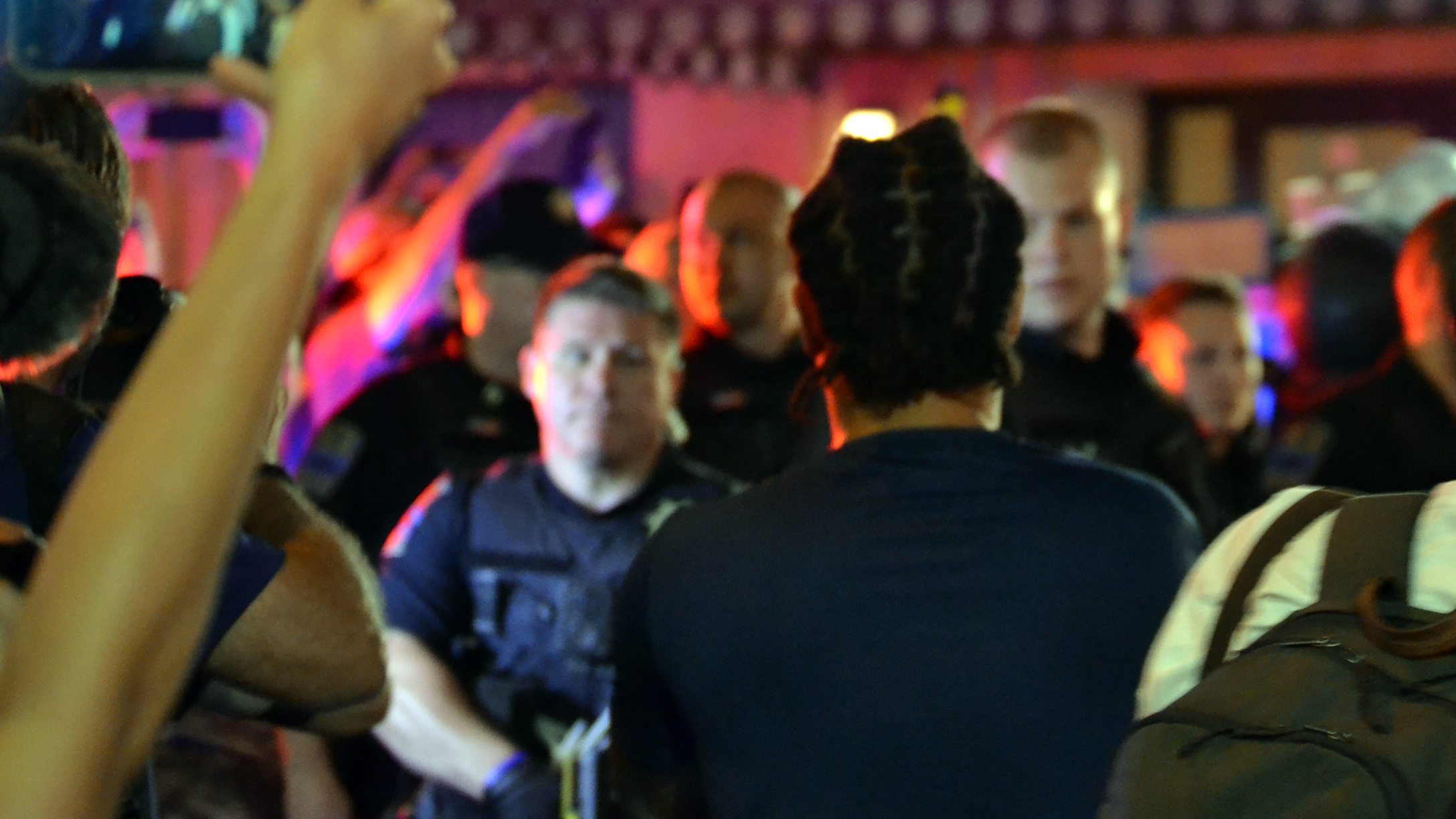I grew up in the Tulsa suburb of Owasso, where I attended a private school until grade six. Our education was exemplary. We had close relationships with our teachers, who took the time to get to know us and help us when we struggled. We had regular recess and nutritious lunches. We learned about the Holocaust, and I started learning the Hebrew alphabet in kindergarten; our school was Jewish, though not all the pupils were. We received quality sex education through a contract with Planned Parenthood. We heard speakers like Jim Inhoffe and Jane Goodall. The playground was amazing.
Oil executives and political leaders sent their kids to my school. Local philanthropists bankrolled part of each student’s tuition. Tulsa made sure that these children received the best education money could buy. Some of my classmates’ names can still be found on local buildings, decades of philanthropy written across the city on monuments, hospitals and museums.
Not all my classmates were rich. My own upbringing was firmly middle-class. My father was a public schoolteacher, and my mother a staff attorney at the City Court of Appeals; I lived the life of a middle-class white kid from central casting. I played baseball and went to camp in the summer. I spent too much time on computer games. I liked Harry Potter and Legos. My parents rejected our old Southern Baptist church when I was a child, but we still prayed before dinner. My parents were critical of consumer culture, but Christmases and birthdays always came with gifts.
That was the lovely side of growing up in Tulsa. Later, I would learn about another side.
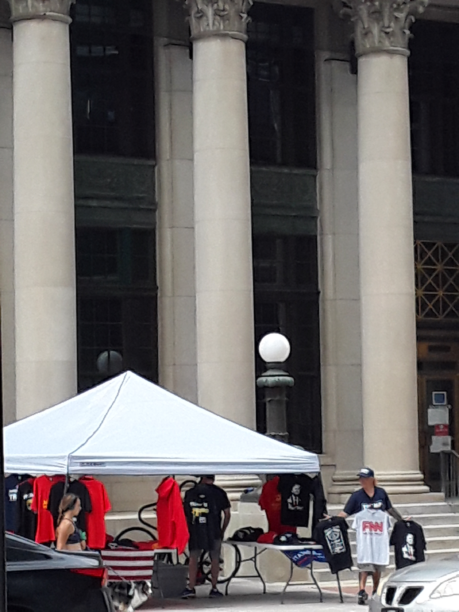
Donald Trump came to Tulsa on the day of the summer solstice. The concrete, steel and blacktop of the city’s downtown area warmed rapidly after the morning cloud cover dissipated. The longest day of the year was a scorcher, the city marinated in the heavy wet heat of Oklahoma’s Green Country. But for the President’s supporters, some of whom had been camping in the area for days, the risk of heat stroke was a minor inconvenience compared to the thrill of seeing their heroic president.
A secure area had been set up around the BOK Center on the west side of downtown. A small army of the President’s supporters established themselves just outside this zone. Every few minutes a protestor would roll through, blasting anti-Trump music or shouting.
Oklahoma is strategically unimportant in national politics; it’s a reliably conservative state with district maps favoring rural counties, worth few electoral votes. But Trump is a showman first and foremost, and Tulsa is the perfect place for a Trump rally—a slice of pure Americana right in the middle of the country, famous for oil, cowboys and Indians. Locals take pride in the music scene, the food, and the growing downtown area. With the Covid-19 pandemic ravaging the country, the President needed a personal morale boost, to see himself on TV surrounded by a besotted MAGA crowd. Tulsa offered him a blissful respite from reality.
Perhaps just as importantly to Trump Republicans, some of the worst racially-motivated violence in America’s history took place here in Tulsa. The city’s founding fathers were entrenched in racist institutions. Law enforcement in this city has historically targeted poor, Black neighborhoods. In stoking the fears and insecurities of white Americans, Trump’s ascent to the White House was fueled by the same racist flames that burned down Tulsa’s Greenwood district in 1921. He wanted to do it again, and where better to begin than Tulsa? The dark side of America is here, too.
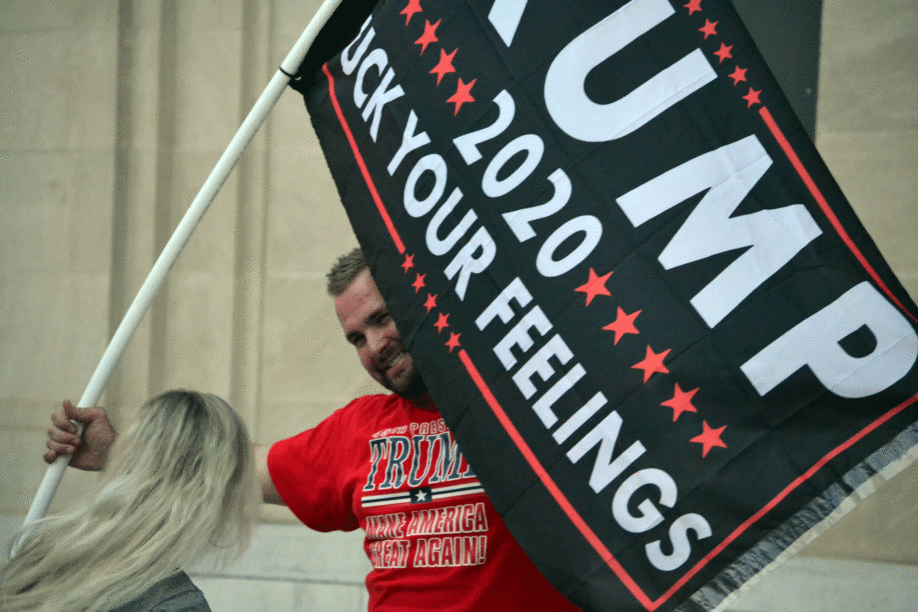
Trump lumbered into Tulsa that blistering Saturday and was given a hero’s welcome by Oklahoma Republicans eager to please their party’s leader. Tulsa Mayor G.T. Bynum called the event “an honor.”
Oklahoma Governor Kevin Stitt and Mayor Bynum had welcomed the rally with open arms, despite the opposition of Tulsa Health Department director Dr. Bruce Dart, whose prescient warnings of potential disaster due to the growing pandemic fell on deaf ears. The rally went on as planned, and Tulsa police detained protesters throughout the day at the behest of campaign staffers, as if they were Trump’s personal security guards.
Within two weeks weeks of the rally Herman Cain and Kimberly Guilfoyle, both members of Trump’s inner circle who attended the rally, had been diagnosed with Covid-19. Tulsa has seen a suspicious uptick of several hundred cases, although the White House denies that the rally was responsible. “Connect the dots,” said Dr. Dart in a press conference.
The Creek refugees of the Trail of Tears selected as their meeting place the Council Oak, a venerable behemoth now hemmed in by oil mansions and condominiums. When Trump came to Tulsa on June 20, protestors gathered at Veteran’s Park, a stone’s throw away. There was a voter registration booth set up, and volunteers gave away water and food. Masks were worn and social distancing was observed. From a stage overlooking some dozens of protesters, a man sang “Your knee is on my brother’s neck.”
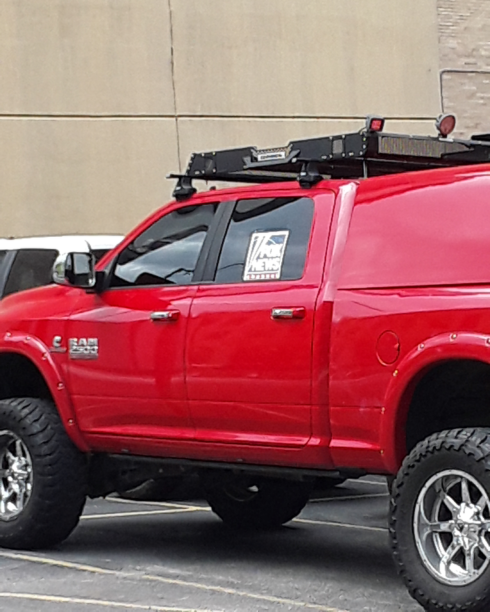
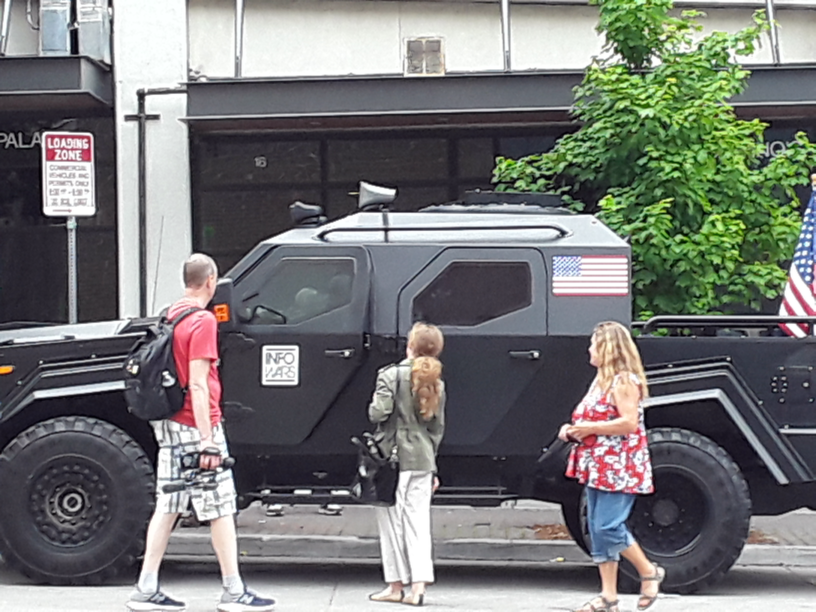
About a mile and a half away, the Trump camp was packed with tents in close proximity. No water tent or relief station could be seen, but one could buy Trump gear in any size or configuration. Fox News rolled out a big red combat truck, a goofy stunt rivaled only by the materiel dispatched by Infowars. The crowd was thick with reporters; throughout the day they covered intermittent scuffles with the protestors, a few of whom were arrested. Later on the President would wildly exaggerate this scene, inflating it into a leftist onslaught that had somehow prevented his rally from reaching its full potential.
There were scattered reports of Trump supporters harassing passersby in the days before the rally, or roaming around looking for trouble; friends I talked to, or heard from on social media, were vastly more worried about them than they were about the protestors. Local businesses boarded up their windows. An old friend who lives in my apartment complex cut a camping trip short in the interest of being close to home. Our building is roughly between the sites of the protests and the rally. We were gripped with the same general sense of directionless anxiety that seemed to suffuse the whole city.
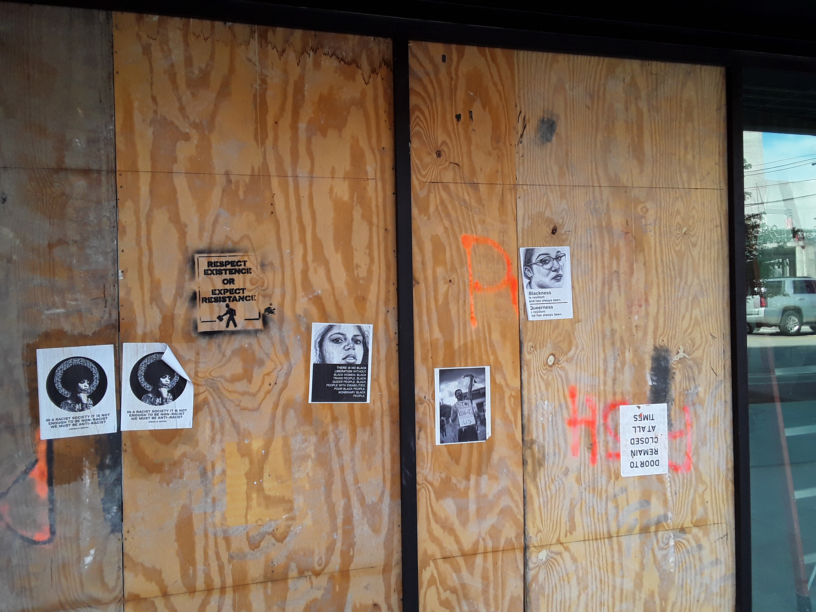
Learning about the Holocaust as a child, I wondered what it must have been like to live in Nuremburg during the Nazi rallies: to see the regime’s supporters gleefully disregard the lives and safety of their countrymen, to exult in cruelty and ignorance and, if they could, take some small piece of the magic home with them. Now, in a small way, I believe I understand.
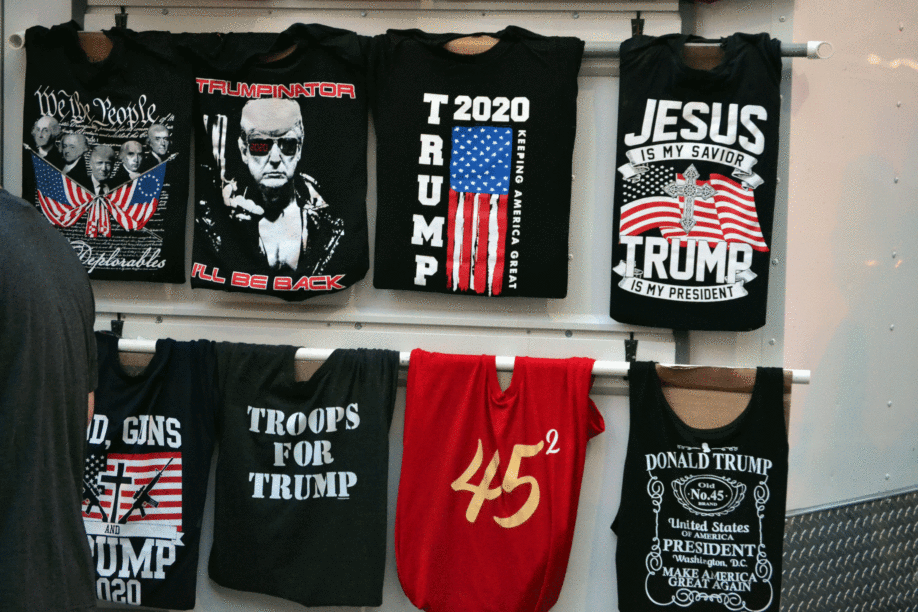
Trump’s presence in Tulsa was especially painful for Black Tulsans because he had chosen to host his rally on Juneteenth, almost 99 years to the day after the Tulsa Race Massacre.
The young state of Oklahoma had some of the most severe Jim Crow laws in the United States in the early 20th century, which prevented the Black population of Tulsa from shopping in white-owned stores or owning property in white neighborhoods. Ironically, this led to an accumulation of wealth in the Black district of Greenwood, as the growing African American middle-class was obligated to spend money within the Black community. Eventually Greenwood became the wealthiest Black neighborhood in the country.
This growing affluence of the Black community stirred resentment in the city’s white populace. In 1921 a 19-year-old Black boy was accused of assaulting a 17-year-old white girl. Black and white Tulsans confronted one another outside the county jail, shots were exchanged and 12 people died, all but two of them white. White Tulsans responded by attacking Greenwood, killing wantonly and destroying homes and businesses. Privately owned planes dropped firebombs while white passengers fired on Black Tulsans. Eventually the National Guard was called and martial law declared. Three hundred were killed, ten thousand were displaced, and damages were never paid. Survivors were crowded in detainment centers. Ultimately an all-white grand jury would lay the blame for the violence on Black Tulsans.
In May of 2020, Human Rights Watch released “The Case for Reparations in Tulsa, Oklahoma,” which argues that the effects of the race riot are still felt today. The theft of property that began a century ago gave way to redlining and redistricting that ensured North Tulsa stayed poor and segregated. Oklahoma schools are underfunded as a rule, and North Tulsa schools are no exception. Life expectancy in some North Tulsa neighborhoods is more than ten years lower than in white South Tulsa.
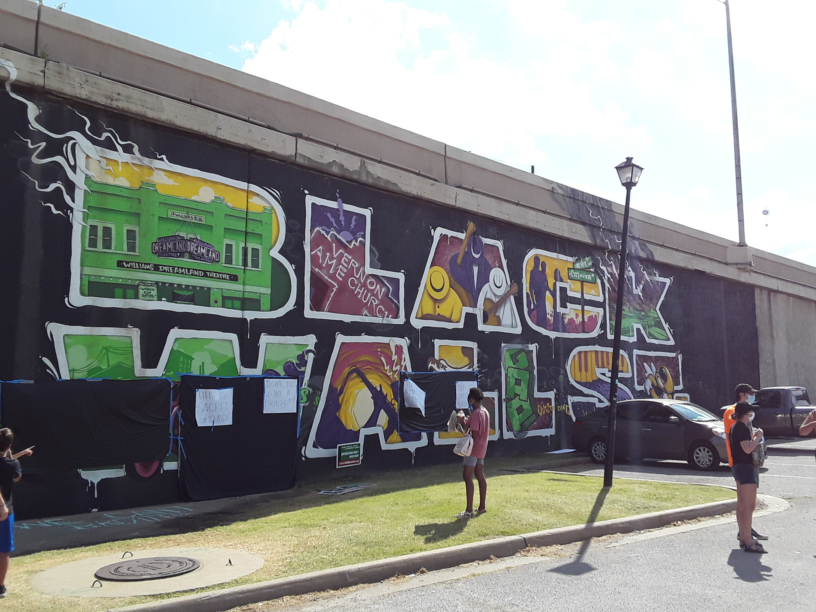
Vernon AME Church, where Black Tulsans took shelter during the Massacre, still stands. Across the street is the Black Wall Street Memorial, an onyx slab naming those killed.
Many monuments to Black Tulsans’ stolen legacy exist uncomfortably alongside signs of gentrification: a baseball field, a branch of Oklahoma State University, upscale housing and dining. Interstate-244, adorned with murals dedicated to Black Tulsa, bisects the historic Greenwood area, reinforcing the North-South racial segregation that has existed in Tulsa since the city was founded.
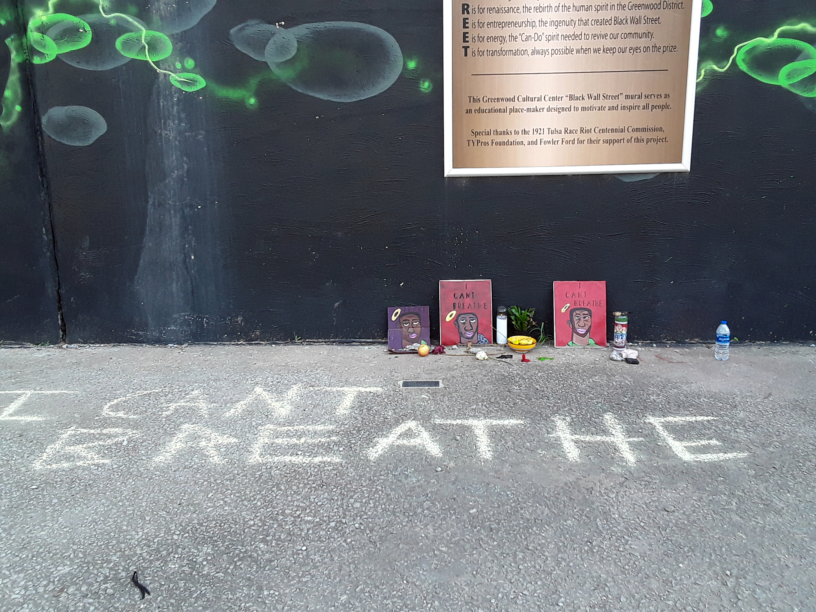
My first college job was giving pedicab tours of Downtown. When the tour made its way to Greenwood, I pointed out the dozens of little black rectangles dotting the sidewalk. Each one is a plaque commemorating a home or business that was destroyed and never rebuilt. As recently as last year, some of the plaques have been damaged or gone missing, possibly because of construction in the area.
When Trump came to Tulsa in June, it had been only three weeks since the killing of George Floyd in Minneapolis. Events like these bring back bad memories for Tulsa, because the city’s legacy of racial violence remains largely unreckoned with, and indeed still persists. Officers in Tulsa police lower-income Black neighborhoods much more heavily than others, in the sadly familiar American pattern. Just four years ago, during a traffic stop, Tulsa Police Officer Betty Shelby shot Terence Crutcher, an unarmed Black motorist, in the back of the head.
Police corruption and abuse have long been rampant here. A year before Betty Shelby fired on Terence Crutcher, Reserve Deputy Robert Bates killed Eric Harris, an unarmed Black man. It emerged that Bates, a personal friend of Sheriff Stanley Glanz, was totally unqualified for the job. Glanz eventually pleaded guilty in 2016 to a charge of “wilful violation of the law.” A new sheriff’s administration uncovered still more corruption, including, as recently as 2017, the discovery of a corporal in the Sheriff’s Office who admitted to stealing from inmates in Tulsa’s county jail.
A lawsuit was brought against Glanz and current Sheriff Vic Regalado relating to the death of Elliott Williams, a Black U.S. Army veteran who died on the floor of the county jail in 2011. Owasso police officers had broken Williams’ neck during his arrest. Jailers had mocked him and accused him of faking his injuries, even after days of being unable to feed himself.
Glanz lost the suit and was ordered to pay $10.2 million for violating Williams’ Eighth and 14th Amendment rights. During the trial, Glanz defended the use of the term ‘Negroid’ as rooted in law enforcement tradition and blamed “their lifestyle and the conditions that people find themselves in,” for the deaths in his jail.
When I was about 11, we moved to West Tulsa, a historically blue-collar neighborhood situated on the West Bank of the Arkansas River. Despite only being a few short miles from downtown Tulsa, the West Side might as well be a hundred miles away. It feels much more like a small town, with a relatively tight-knit community and families that have been in the area for generations. Once I heard one of my father’s students remark that he had never been downtown in all his 16 years. An exasperated gym teacher once screamed at our class that one day we would learn there was more to the world than the West Side.
In sixth grade I enrolled in an area middle school that fed into my father’s high school, transitioning from a well-run private elementary school to an underfunded public middle school. Getting an education proved difficult in this chaotic environment.
Most of the teachers in school were white. Kids of the same color tended to hang out together, and most of my own friends were white. The school was rough. I remember seeing a Black student handcuffed to a bench once, while walking between classes. No one else was around. Someone had chained him there and walked off. I don’t know what he’d done. I never saw him again.
In eighth grade, a quiet kid set the vacant home-ec room on fire. The building retained an acrid tang and a stained aspect for the rest of the year. As the school year wound down, teachers were powerless to stop the fights, some more like melees that would clog hallways and stairwells—a mindless, seething mass of teenage chaos.
Among the staff there were many earnest, serious teachers who struggled against a legion of obstacles to give us a decent education. When the school’s heater broke in the middle of the winter it took weeks for it to be repaired. My language arts teacher’s lips turned blue, but she never took a day off.
Others snapped, and gave in to the chaos around them. There was a music teacher who played it cool and relatable, bringing his Playstation to class on Fridays for karaoke. Later, he was deployed to New Orleans during Hurricane Katrina. On his return, he choke slammed an unruly student in front of the class. I remember the terrifying blind rage he flew into, throwing the boy around the room by his neck. I was called into the office with another boy to talk to administrators because we had both seen the whole thing. I don’t remember what I told them. The teacher ended up getting an administrative admonishment for using “inappropriate force” against a student, but stayed in the same school. He left just a few months later, amid accusations that he’d cracked a seventh-grade girl’s skull.
The city fathers left a legacy hostile to Tulsa’s working-class, linked to violence against activists and people of color. Unlike my philanthropically-funded elementary school, public schools in Tulsa are funded by property taxes. Poor neighborhoods are starved of funds for education, and the result is a downward spiral in the overall quality of life for whole communities where the poorest have been left to fend for themselves. Over time that hostility has soured into a tradition of indifference toward the well-being of everyday people, who’ve sunk lower with each generation. By the early 21st century schools had deteriorated to the point that there is little hope now that any education can be accomplished in these schools. It happened in blue-collar West Tulsa, it happened in Black North Tulsa, and something similar is happening in every so-called ghetto in the nation.
My mother died the summer after I left eighth grade, and I moved in with an aunt and uncle who lived in middle-class midtown. I attended a charter high school that emphasized the arts and humanities. This school had smaller class sizes and longer class times, and also had fewer rules and restrictions. There was no uniform. Gym classes included yoga and meditation alongside running and pushups. We called many of our teachers by their first names. Teachers would eat lunch with students, and I remember discussing history, politics, philosophy, and even religion over our meals. This familiarity fostered mutual respect, and I still consider it the best education I ever got.
But injustice didn’t disappear with my change in circumstances. On a school trip once, I remember a Black classmate telling me that he was more comfortable when he visited Chicago. Fewer weird looks, fewer suspicious storekeepers, less fear that he might be viewed as a criminal. In Chicago he felt more like just another face; that was a luxury for a Black teenager from Tulsa. My privilege had allowed me to leave my struggles on the West Side. He was not so fortunate.
After graduation I attended the University of Tulsa, another private school. During the time I attended, the University’s administration repeatedly put the financial and public relations concerns of the University ahead of the needs of students. A lawsuit against a TU athlete alleging sexual assault against another student was dismissed in what many saw as a cover-up. More recently, the school’s administration implemented a deeply unpopular plan named True Commitment, gutting most programs not directly linked to industry jobs and driving away many of the best teachers. Even the Law School’s Native American Law program, one of the best in the country, was cut from offerings. The University carries on the city’s tradition of indifference to the public well-being.
Before Trump had even opened his mouth, much of America already knew that the much-hyped rally had received a disappointing turnout. As the President ad-libbed his way through a tepid pep talk for the meager crowd of 6,200, protestors from the Veteran’s Park camp marched north along Boulder Avenue, verbally clashing with the President’s supporters at the Fourth Street intersection. Tensions rose. Some protesters prevented a line of police vehicles from proceeding down Boulder Avenue, while others pleaded with their fellows to leave the area and regroup on Greenwood.
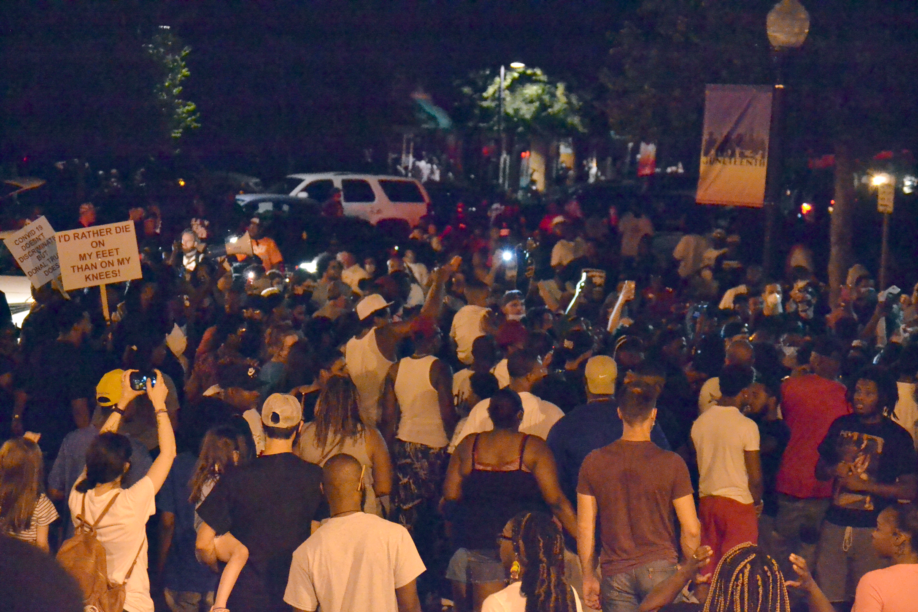
“Don’t give nobody a reason, y’all,” came a voice through a megaphone. “Chess, not checkers.”
But the streets remained choked with protestors and media. In the distance, an engine revved. A phalanx of Tulsa Police officers deployed pepper balls, and for half a minute chaos took over.
I was not directly in the pepper spray, but I felt a slight sting in my throat and eyes. As I scrambled away from the cloud of capsaicin, my city felt like a coin suspended in the air.
The protestors regrouped and pushed police back along Boulder. Eventually, the crowd gave in to the pleas of organizers and turned north, making its way to Greenwood.
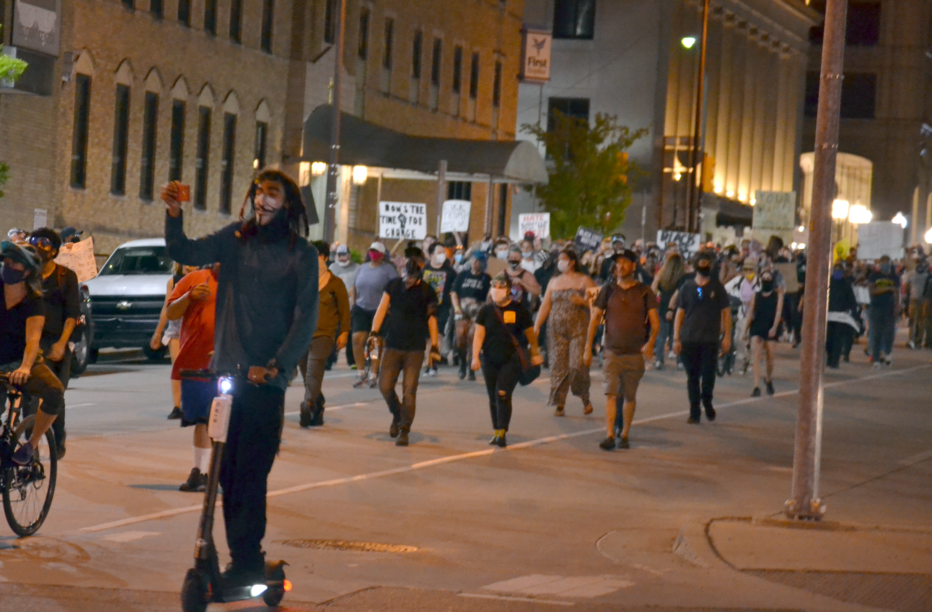
Juneteenth was still in full swing, and Greenwood Avenue was aglow. Classic cars and tricked-out motorcycles took turns promenading down the street while a rapper commanded a crowd of swaying youth, engines roaring against a backdrop of rhythm and lyrics. Partiers did their best to social-distance on sidewalks and under the overpass, with mixed results. “Black Lives Matter” was projected on the side of Vernon AME, speaking truth in three-foot-tall letters and stamped with a raised fist.
What had begun as a potentially dangerous protest transitioned smoothly into celebration, righteous anger metamorphosed into fierce joy. When the march reached Vernon AME, the crowd erupted in cheers. From the steps of that church, a structure that survived the burning of Greenwood and sheltered many Black Tulsans, a woman with a megaphone spoke to the crowd of cheering protestors.
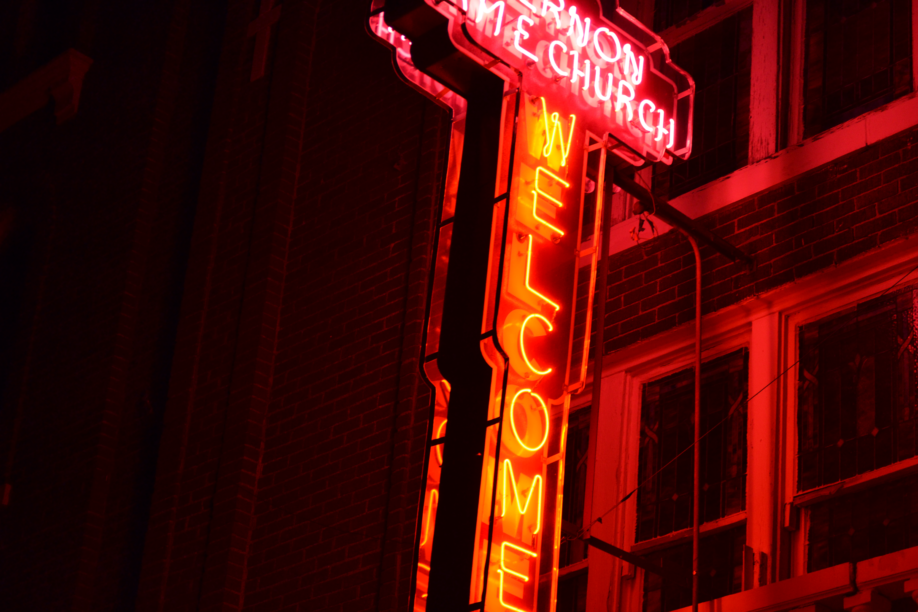

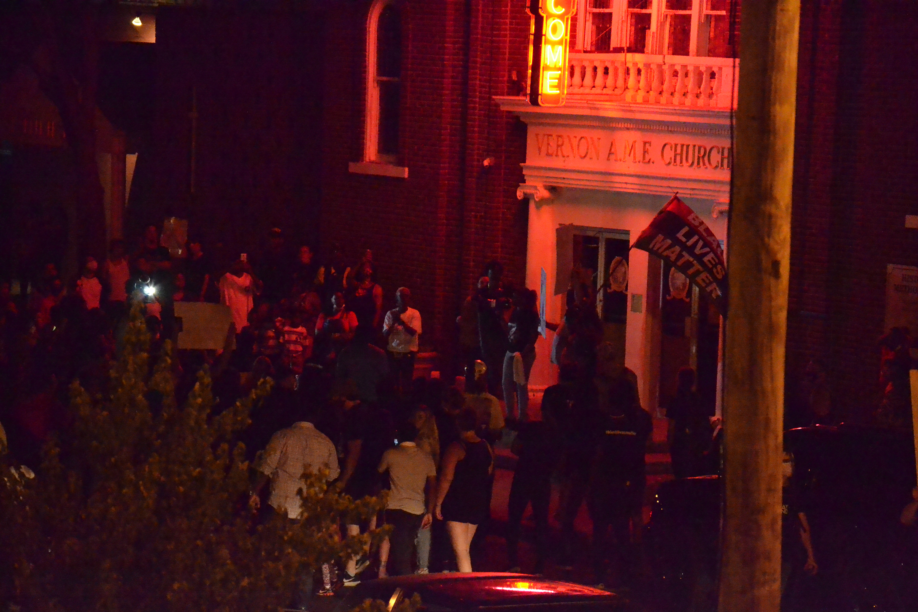
“We were really afraid that they would burn this place again, but you said ‘Never again!’” she shouted. “Greenwood matters!”
The crowd returned her chant, a hundredfold. Voices from all over Tulsa filled the night sky with affirmations. A century after white Tulsans turned on their Black neighbors, a demagogue tried to channel that same fear and hate to his own purposes. But that night in Tulsa, Trump found what he is increasingly finding all over the country: a new, more diverse generation that isn’t buying his bullshit. Freedom rang in Greenwood as Air Force One carried a defeated President back to D.C.
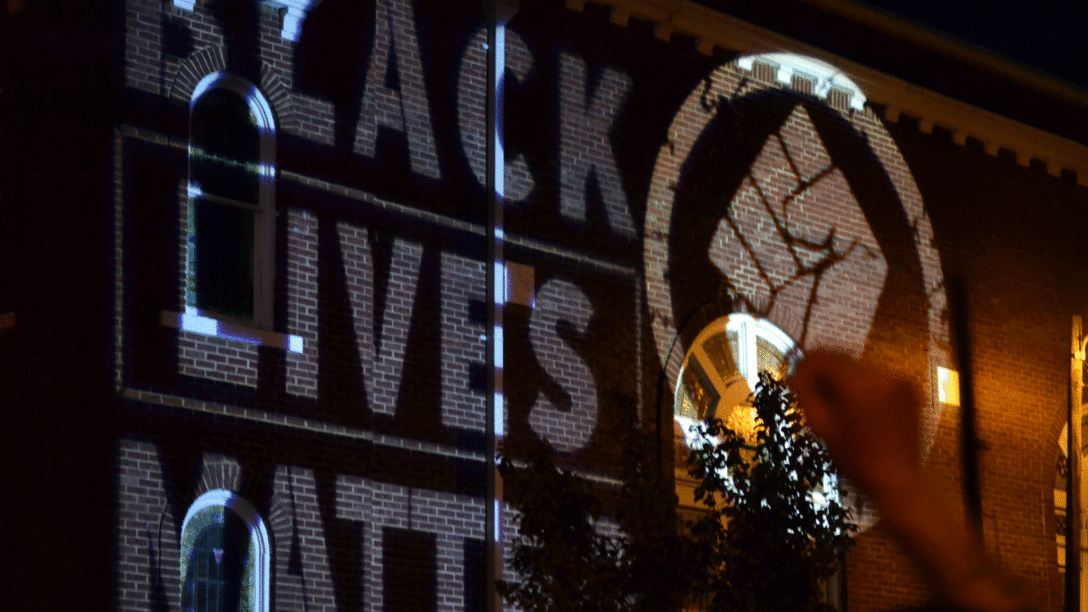 photos courtesy of the author
photos courtesy of the author
